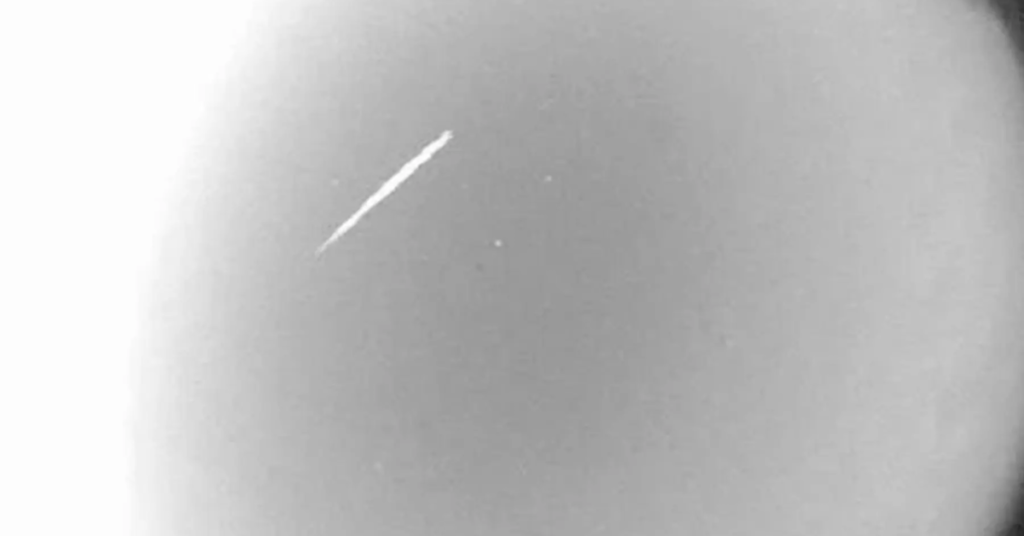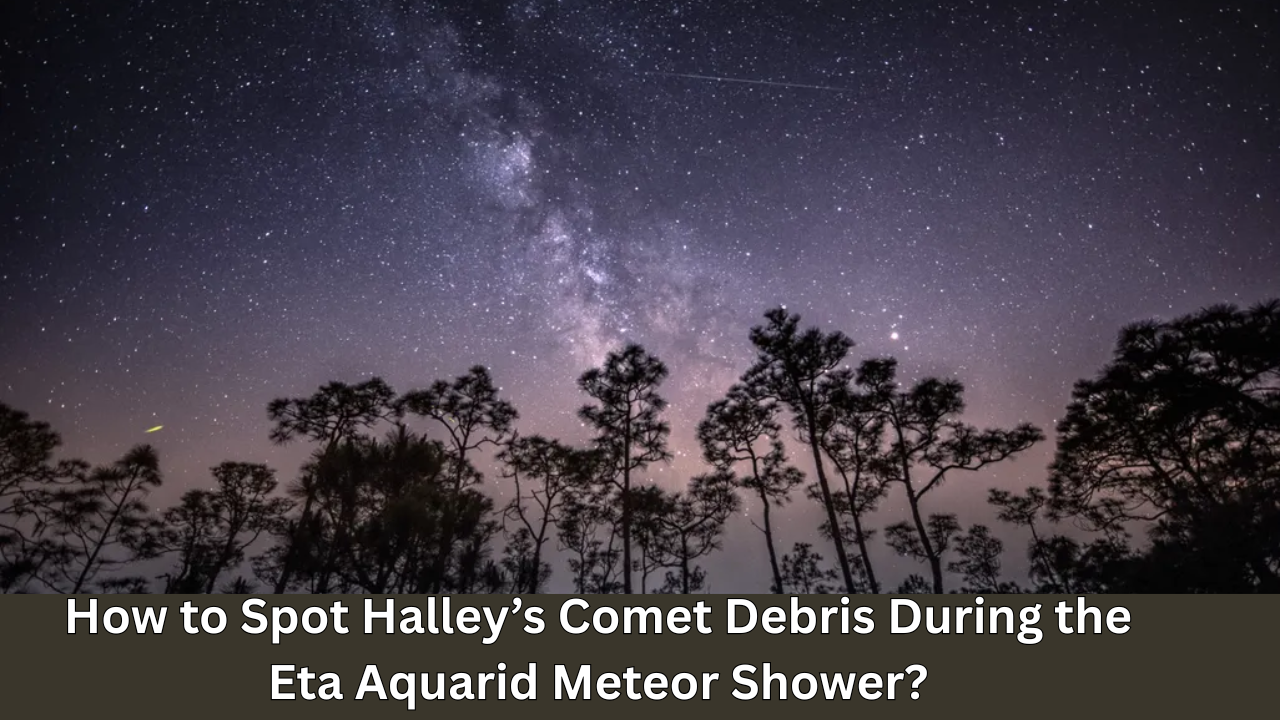Halley’s Comet is one of the most famous celestial objects, making a dramatic visit to Earth’s neighbourhood once every 75 years. This comet has left behind a lasting legacy: the debris it left in its wake creates not one, but two major meteor showers each year. Among them is the Eta Aquarid meteor shower, which is an excellent opportunity to witness the remnants of Halley’s Comet lighting up the night sky.
The Eta Aquarid meteor shower, named for the constellation Aquarius from which it appears to radiate, provides an annual spectacle that brings the debris of Halley’s Comet to our skies. This meteor shower is especially interesting because it gives skywatchers the chance to see space rocks that originated from one of the most famous comets of all time.
When the Eta Aquarids make their appearance, “you’ll know that Earth is crossing the path of the most famous comet,” says Shauna Edson from the Smithsonian’s National Air and Space Museum.
Understanding the Meteor Shower
A meteor shower occurs when Earth passes through the debris trail left by a comet or asteroid. For the Eta Aquarids, this debris comes from Halley’s Comet. Halley’s Comet travels on an orbit around the sun that takes it through the inner solar system every 75 years. As the comet nears the sun, it sheds particles that spread out in a long, thin trail, which Earth intersects every spring. This intersection causes the particles to burn up in our atmosphere, creating the streaks of light we see as meteors or “shooting stars.”
Unlike the slow-moving meteors from some other showers, the Eta Aquarids are known for their speed. NASA’s Bill Cooke describes them as “pretty fast meteors.” This means that when you see one, it will likely streak across the sky very quickly, making the display even more thrilling. The meteor shower’s speed is one of the features that make it such a captivating event to watch.
The Eta Aquarid Meteor Shower: What to Expect
The Eta Aquarid meteor shower typically peaks in early May, making it an excellent way to welcome the warmer months. The peak of this meteor shower in 2025 is expected to occur in the early hours of May 6. During the peak, skywatchers can expect to see around 10 to 15 meteors per hour, depending on ideal viewing conditions.
However, the moon’s brightness can sometimes hinder visibility. This year, the moon will be nearly two-thirds full, which means the bright light from the moon could compete with the meteors, making them harder to see. Despite this, skywatchers may still be able to catch glimpses of the meteors if the skies are clear.
The Eta Aquarid meteor shower runs from late April to late May, so there’s ample time to catch a glimpse of the celestial event. Even if you miss the peak, the meteors can still be visible in the days leading up to and following the peak.
Why Halley’s Comet Matters
Halley’s Comet, which is visible to Earth once every 75 years, has fascinated astronomers for centuries. It is one of the few comets visible to the naked eye and has made its way into human culture and history. Its passage through the solar system has often been marked by awe and intrigue, inspiring myths and stories throughout various cultures. The comet was famously observed by astronomers such as Edmond Halley, who predicted its return and for whom the comet was later named.
The debris from Halley’s Comet has contributed not only to the Eta Aquarid meteor shower but also to another major meteor shower, the Orionids, which occurs in October. The presence of these meteor showers reminds us of Halley’s Comet’s lasting impact on the solar system, as its debris continues to interact with Earth every year. This makes the Eta Aquarids not just a meteor shower but a cosmic reminder of Halley’s Comet, which connects us to centuries of astronomical history.
The Science Behind Meteor Showers
Meteor showers occur when Earth moves through the debris trail left behind by a comet or asteroid. As Earth passes through these debris trails, we encounter the small particles that were ejected from the comet’s nucleus.

These particles, mostly dust and ice, are often only the size of a grain of sand or smaller. Despite their small size, when they enter Earth’s atmosphere, they travel at incredible speeds—up to 70 kilometres per second—causing them to heat up rapidly. The friction between the particles and the atmosphere causes them to burn, creating the brilliant streaks of light we call meteors.
Meteor showers are typically annual events, happening at roughly the same time each year. The Eta Aquarid meteor shower is one of the few meteor showers that originate from the debris of a famous comet, and it is unique in its speed and brightness. It’s a fascinating event that offers both amateur and professional astronomers a chance to observe these cosmic phenomena in real-time.
How to View a Meteor Shower
Watching a meteor shower is an easy and accessible activity that requires little more than a dark location and clear skies. Here’s how you can maximize your experience during the Eta Aquarid meteor shower:
- Choose a Dark Spot: Light pollution from city lights is one of the biggest obstacles to seeing meteors. To get the best view, it’s important to find a location away from artificial lights. A rural area or a park away from city lights will give you the clearest view of the meteor shower.
- Watch During the Best Time: The best time to watch a meteor shower is during the predawn hours when the sky is darkest. The later it gets, the fewer light sources there will be, and the better your chances of seeing meteors. Avoid watching the meteor shower near bright streetlights or under a brightly lit sky.
- Look Up and Relax: It’s essential to give your eyes time to adjust to the darkness. This typically takes around 20 to 30 minutes. Avoid looking at your phone or other light sources, as this will interfere with your night vision. Lay back on a blanket or sit in a chair and gaze at the sky to catch the meteors.
- Check the Weather: Cloud cover can obscure your view of the meteor shower, so check the weather forecast in advance. Cloudless nights are ideal, as they provide the clearest skies for stargazing.
- Keep Your Expectations Realistic: Even on the peak night of the meteor shower, you may not see a meteor every minute. Sometimes, you may experience long lulls with no meteors, followed by bursts of activity. Be patient and enjoy the serenity of the sky.
The Best Viewing Locations for the Eta Aquarids
To fully experience the Eta Aquarid meteor shower, it’s important to pick a location with minimal light pollution. Many cities have observatories or public stargazing events that can provide access to dark skies. However, if you’re unable to visit an observatory, here are a few general suggestions for the best places to watch:
- National Parks: These areas are often far from city lights and offer open spaces to watch the sky.
- Rural Areas: Any location far from city light pollution, such as a countryside location or a small town, can provide an excellent view.
- Beaches or Lakes: Coastal areas or lakeshores often offer unobstructed views of the night sky, making them great spots for meteor showers.
Other Meteor Showers to Watch For
The Eta Aquarids are just one of several meteor showers that occur annually. While the Eta Aquarids are one of the most exciting events to witness, there are other meteor showers throughout the year that are also worth observing. Some of the most popular meteor showers include:
- Perseids (August): This is one of the most well-known meteor showers, producing up to 100 meteors per hour during its peak.
- Geminids (December): The Geminid meteor shower is often the most reliable and consistent, producing brilliant meteors in December.
- Orionids (October): This meteor shower also comes from Halley’s Comet debris, like the Eta Aquarids, and is visible in the fall.
Summary of Key Viewing Tips:
- Ideal Time: Early predawn hours
- Best Conditions: Clear skies, low moon visibility
- Avoid: Bright light sources like city lights and the moon
- Viewing Duration: Eta Aquarids last until May 28
The Eta Aquarids provide a spectacular opportunity to witness one of Halley’s Comet’s many gifts to Earth. Whether you are a seasoned stargazer or a beginner, this meteor shower is a beautiful and accessible way to connect with the cosmos and experience the thrill of watching meteors streak across the sky. So, gather your friends or head out alone and enjoy this amazing celestial event.

Deepak Grover is a dedicated content writer at OTE News, specializing in government affairs, public policy, and current events. With a keen eye for detail and a passion for factual reporting, he ensures readers receive accurate and insightful news. Deepak holds a degree in Political Science and has experience in research-driven journalism.
When not writing, he enjoys reading historical books, exploring hiking trails, and staying updated with global political trends. His commitment to ethical journalism makes him a trusted voice at OTE News.




